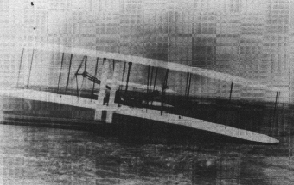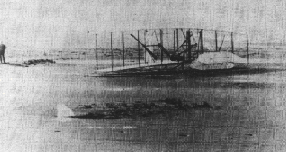At twenty minutes after eleven Wilbur started on the second flight. The course of this flight was much like that of the first, very much up and down. The speed over the ground was somewhat faster than that of the first flight, due to the lesser wind. The duration of the flight was less than a second longer than the first, but the distance covered was about seventy-five feet greater. Twenty minutes later the third flight started. This one was steadier than the first one an hour before. I was proceeding along pretty well when a sudden gust from the right lifted the machine up twelve to fifteen feet and turned it up sidewise in an alarming manner. It began a lively sidling off to the left.
I warped the wings to try to recover the lateral balance and at the same time pointed the machine down to reach the ground as quickly as possible. The lateral control was more effective than I had imagined and before I reached the ground the right wing was lower than the left and struck first. The time of this flight was fifteen seconds and the distance over the ground a little over 200 feet. Wilbur started the fourth and last flight at just 12 o'clock. The first few hundred feet were up and down, as before, but by the time three hundred feet had been covered, the machine was under much better control. The course of the next four or five , hundred feet had but little undulation.

Three more flights were made on December 17. Here, on the third flight of the day, Orville skims over the dunes, flying a distance of 200 feet in 15 seconds.
